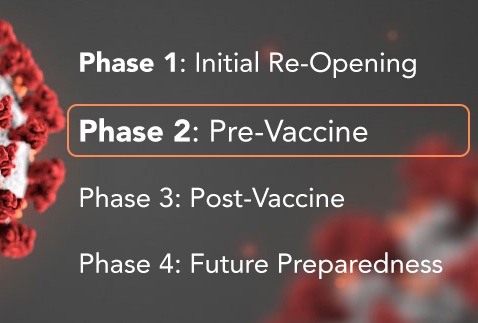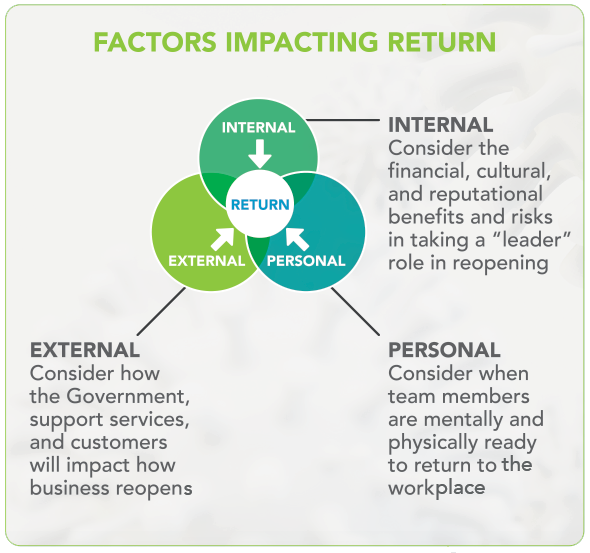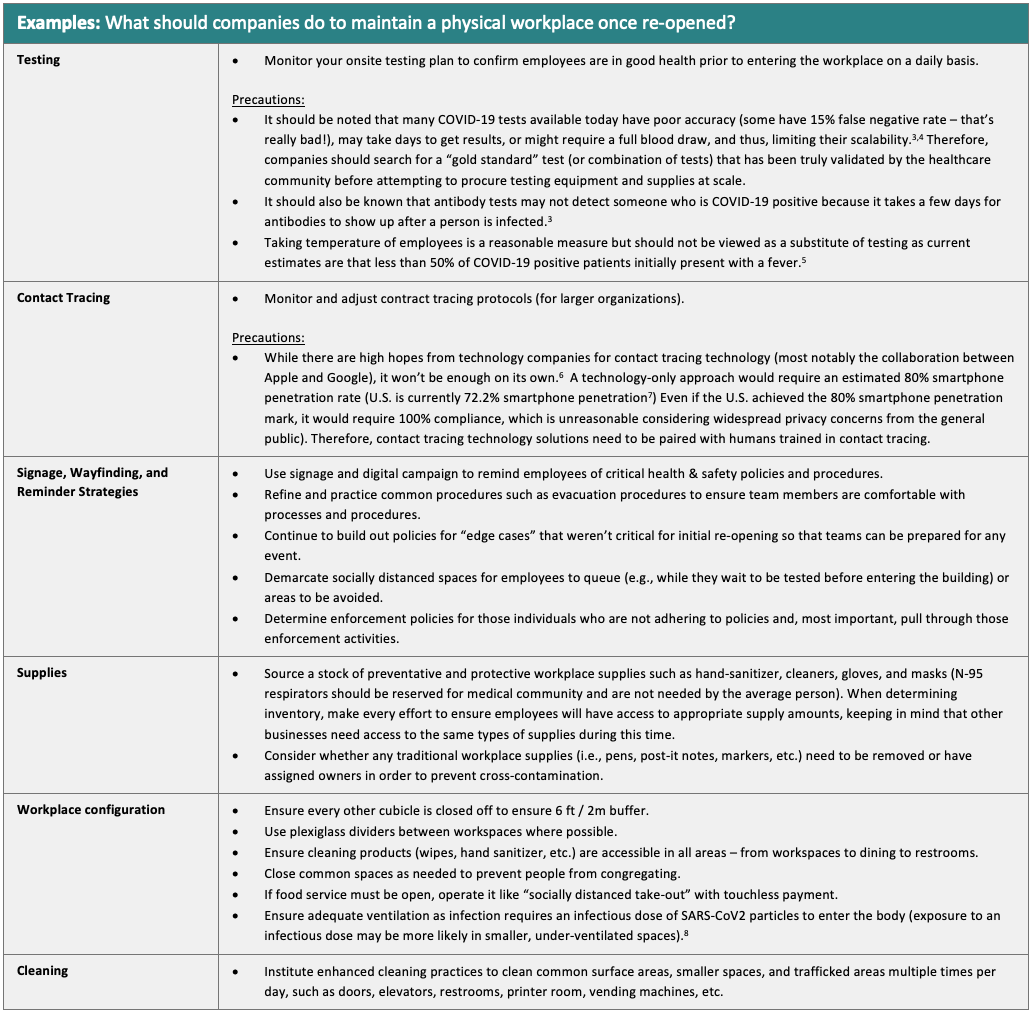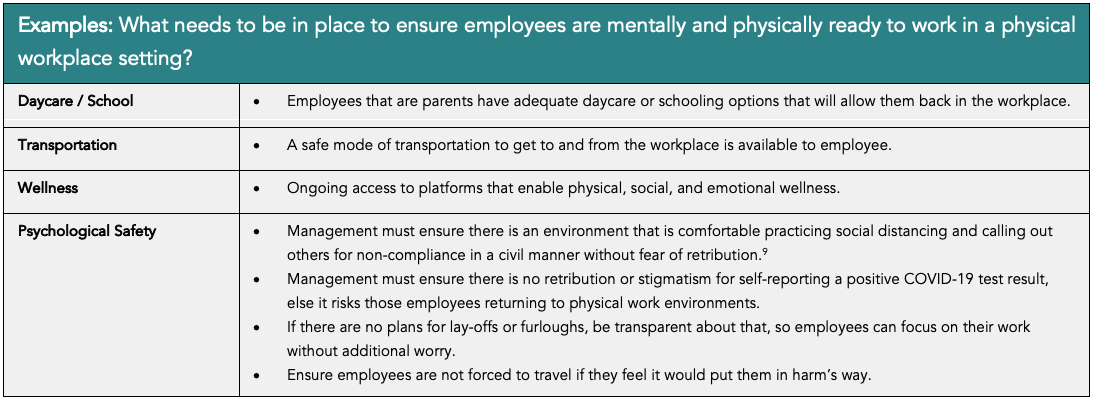COVID-19 business response – Phase 2: Leading during the pre-vaccine stage
While still reckoning with the tragic consequences of the ongoing global pandemic, we are starting to see some light at the end of the tunnel. Today, most companies have a COVID-19 task force in place that includes, or at least reports to, senior leadership and has been responsible for assessing the vulnerabilities that were exposed by the expedited transition to a remote model. As an outcome of these assessments, COVID-19 task forces have been empowered to identify initiatives and sometimes strategic pivots that will be required to build a better, more resilient future.
As some companies have started the slow process of returning to the physical workplace, COVID-19 task forces are unlikely to dissolve. Some form of these task forces will likely continue; monitoring the fluid rules and regulations for re-opening (or future re-closing). These groups have a vital role to play beyond just logistical scenario planning. Many task forces will evolve, continually informing company strategy as COVID-19 cases fluctuate across different regions. Additionally, these task forces will need to learn and adapt as results of earlier decisions play out.
This insight focuses on what companies should be doing during Phase 2: Pre-Vaccine, the time-period prior to a widely available vaccine (or treatment).

As the previous Insight introduced, there are three factors to consider in COVID-19 response plans. These also apply to Phase 2:

Below are key questions for thinking about each type of readiness, and actionable examples of how companies might proceed to ensure each type of readiness during Phase 2.
External readiness
External readiness can be understood in terms of answering the following questions:
- What government guidelines or regulations must we comply with at the national, regional, or local level to operate a physical workplace once it has re-opened?
- What social, cultural, or economic impacts must we understand to operate a workplace once it has re-opened?
- Which criteria (i.e., total number of local cases, new case rate, R number, number of deaths, etc.), if met, would constitute a new outbreak, and thus, require a re-evaluation of the workplace status?
Federal, state, and/or local government regulations and guidelines will dictate the criteria under which businesses can operate once they re-open. Whether these guidelines are related to physical distancing requirements, group size limits, entry checks, or even changes to common/communal areas, in the U.S., the Federal Government has largely delegated responsibility for these guidelines to state and local governments. This presents a challenge for companies with operations in multiple states, each with their own circumstances and criteria for operating. Some states, like New York, have clearly defined criteria based on metrics, while others have not been as explicit.
Internal readiness
Internal readiness can be understood in terms of answering the following questions:
- What are the responsibilities of the employer to enforce appropriate distancing and hygiene for employees who choose to return to the workplace?
- Once a physical workplace location has re-opened, how are policies and processes maintained and adjusted as external guidance and employee sentiment evolves?
- What external and internal metrics will physical work locations use to measure their approach to re-opening and inform future changes to policies?
- What role does “headquarters” play in decision-making versus localized leaders who can factor in community–level dynamics for a physical location?
It is in the best interest of employers to understand and take seriously their responsibilities pertaining to ensuring the physical and psychological safety of their teams, which may, at times, include enforcement of policies that team members are not adhering to. Not only are these responsibilities paramount as moral obligation, but also because employees will be both more motivated and more loyal in the future when they know leadership has prioritized their well-being during this time of crisis.
While no one policy or procedure on its own is enough to ensure a workplace remains COVID-19–free, actively communicating status against defined metrics and gaining buy-in to any changes in policy will promote good will with employees.
Further, since a lack of herd immunity1 is likely to result in secondary spikes in COVID-19 cases, clear procedures that anticipate and can flexibly address future cases are vital and urgent. These procedures must be reviewed, adjusted and consistently communicated. Further, should new outbreaks occur, plans should be put in place for rapid and safe workplace closures, building on earlier lessons learned. Having these procedures in place will allow businesses and employees to prepare now, mitigating future shock and disorientation to employees and their families.


Note: Additional guidance on preparing facilities can be found at aiha.org.
Part of maintaining the workplace once it has reopened includes ensuring that all team members are consistently aware of policies and procedures and that they understand their responsibility. Where possible, ensure training policies are managed online and are accessible for both employees and 3rd party companies. Continually refine and adjust policies as more is learned about COVID-19 and as government regulations evolve. Specific policies that should be actively managed include:
- Onsite scheduling (including staggered schedule where possible)
- Transit/commuting and travel
- Entrance and exit procedures
- Social distancing and hygiene, including any directive foot traffic pathing
- In-person meeting criteria including scheduling implications for “room changeover”
- Work from home policy
- Re-closure and/or reduced onsite presence
Personal readiness
Personal readiness can be understood in terms of answering the following questions:
- What are the ongoing responsibilities of employees who have returned to a physical work environment?
- What needs to be in place and operating consistently to ensure employees are mentally and physically able to commit to being onsite?


Change management: Helping employees adjust to the new normal
The criteria above paint a very different workplace picture than the one employees were accustomed to. Adjusting to the new normal in the workplace during the Pre-Vaccine phase will require commitment on the part of both employers and employees, but it is employers who have ownership and responsibility over the change management process. Conducting the workday in an environment that is spaced out in unfamiliar configurations, includes physical barriers where none previously existed, and operates under entirely new protocols will be at a minimum distracting, and at worst distressing, for employees. Employers can manage the adjustment to the new normal by planning for and implementing a variety of change management tactics to decrease distraction and demonstrate support for employees during the adjustment period. Each company’s needs will vary, but ideas include:
- Instituting virtual orientations to the workplace space and new protocols, familiarizing team members and giving them the opportunity for Q&A
- Asking managers to host 1:1 check-ins with their team members specific to the Return-to-Workplace adjustment
- Collect feedback from the overall employee population via surveys on a regular basis
- Invite ideas from employees who are willing to contribute to ongoing workplace planning
- Communicate in advance any upcoming changes as protocols continue to shift and evolve
The more involved and supported employees feel during the Pre-Vaccine Phase, the more likely they are to remain productive contributors even as work, social, and community environments demand continuous change and adjustment.
What strategies should carry into the future?
While employee safety and readiness measures for consideration listed above should be of the utmost importance during the COVID-19 crises, organizations must not let the crisis distract from writing the next chapter of a business’s growth and resilience.
In parallel to rolling out back-to-workplace readiness measures, leaders must conduct future-back strategic planning – that is, begin with the end in mind to envision what you want the company to be using in an appropriate time-horizon (e.g., 3-5 years). Focus on designing a business that will thrive in the “new normal” future, while avoiding the pitfall of simply trying to determine how the components of the existing business model can simply survive. Once the future vision is established and key strategic initiatives identified, the organization must make small bets to pilot these initiatives. Those that make bold decisions to pilot and adapt in a smart way will win the future.
Need help? Contact us to explore if Vynamic can help your Return-to-Workplace initiatives or broader strategic planning to prepare your organization for a more resilient future.
Footnote:
Mina, Michael. “May 8, Coronavirus (COVID-19) Press Conference”. Harvard Chan: This Week in Health podcast. Harvard T.H. Chan School of Public Health. May 8, 2020. Streamed on Spotify on May 17, 2020: https://open.spotify.com/episode/6GQAH2VLdR7FHupYF13GII?si=ayeMUJTJTrW6zlMLARNmEQ
Gawande, Atul. “On GPS: How a Boston Hospital Guarded Against COVID-19”. CNN – Fareed Zakaria GPS. May 17, 2020. Downloaded May 17, 2020: https://www.cnn.com/videos/tv/2020/05/17/exp-gps-0517-gawande-on-the-regimen-for-reopening.cnn
Mina, Michael. “May 15, Coronavirus (COVID-19) Press Conference”. Harvard Chan: This Week in Health podcast. Harvard T.H. Chan School of Public Health. May 8, 2020. Streamed on Spotify on May 18, 2020: https://open.spotify.com/episode/1tWkPtHHHrTDampzHdKTmM?si=0oXvtt7sRAyiHjPv-ruXvw
Ting, Eric. “These are most – and least – accurate COVID-19 tests”. SF Gate. May 6, 2020. Downloaded May 6, 2020: https://www.sfgate.com/coronavirus/article/which-COVID-19-tests-are-accurate-antibody-swab-15250911.php
Guan, Wei-jie, et al. “Clinical Characteristics of Coronavirus Disease 2019 in China”. New England Journal of Medicine. April 30, 2020. Downloaded May 18, 2020: https://www.nejm.org/doi/full/10.1056/NEJMoa2002032
Doffman, Zak. “Forget Apple and Google – Tracing Apps Just Dealt a Serious Blow”. Forbes. May 12, 2020. Downloaded May 14, 2020: https://www.forbes.com/sites/zakdoffman/2020/05/12/forget-apple-and-google-contact-tracing-apps-just-dealt-serious-new-blow/#1379b7462172
O’Dea, S. “Smartphone penetration rate as share of the population in the United States from 2010 to 2021”. Statista. April 8, 2020. https://www.statista.com/statistics/201183/forecast-of-smartphone-penetration-in-the-us/
O’Dea, S. “Smartphone penetration rate as share of the population in the United States from 2010 to 2021”. Statista. April 8, 2020. https://www.statista.com/statistics/201183/forecast-of-smartphone-penetration-in-the-us/
Grenny, Joseph. “5 Tips for Reopening Your Office.” Harvard Business Review. May 20, 2020. Downloaded May 25, 2020: https://hbr.org/2020/05/5-tips-for-safely-reopening-your-office

About Vynamic
Vynamic, an Inizio Advisory company, is a leading management consulting partner to global health organizations across Life Sciences, Health Services, and Health Technology. Founded and headquartered in Philadelphia, Vynamic has offices in Boston, Durham NC, New York, and London. Our purpose is simple: We believe there is a better way. We are passionate about shaping the future of health, and for more than 20 years we’ve helped clients transform by connecting strategy to action.
Through a structured, yet flexible delivery model, our accomplished leaders work as an extension of client teams, enabling growth, performance, and culture. Vynamic has been recognized by organizations like Great Place to Work and Business Culture Awards for being leaders and innovators in consulting, company culture, and health. Visit Vynamic.com to discover how we can help transform your
organization or your career.
Want to learn more? Get in touch!
Other insights.
Jump to a slide with the slide dots.
 Prathima Guniganti
Prathima Guniganti
POV: Ensuring AI-Powered Omnichannel Strategies Deliver Expected Results
Learn how to optimize AI-powered omnichannel strategies for better engagement, data governance, and measurable results in life sciences
Read more Mindy McGrath
Mindy McGrath
The Case for Strategic Transformation: An Executive Conversation with Vynamic’s Leaders
Discover how healthcare orgs drive sustainable change through strategy, leadership, and execution—insights from Vynamic leaders.
Read moreU.S. Federal Health Agency Layoffs Pose Strategic Risk and Disruption to Life Sciences
Layoffs at U.S. health agencies, IRA, and budget cuts disrupt pharma—learn how life sciences can adapt and stay resilient.
Read more
